April 23, 2025


Stephen Vick, executive director of the Infant Welfare Society of Evanston, said moving forward, his organization’s priority will be to “empower parents” to advocate for themselves.

April 23, 2025


Stephen Vick, executive director of the Infant Welfare Society of Evanston, said moving forward, his organization’s priority will be to “empower parents” to advocate for themselves.
By JACK BAKER the daily northwestern
e Trump administration’s closure of Chicago’s regional Head
Start o ce and planned elimination of federal funding for Head Start programs has le many lowincome Evanston families in limbo and several local childcare providers bracing for impact. Head Start is a federally funded
Biss’ planned pick withdraws from LUC race
By HANNAH WEBSTER daily senior staffer
Just over a week a er being informed that Mayor Daniel Biss planned to appoint her to the Land Use Commission, Cat Vielma has decided to pass up the opportunity.
On Saturday morning, Vielma informed Biss of her intention to withdraw from consideration for the seat, she told e Daily in an email.
“While I’m disappointed not to move forward in the appointment process, my commitment to advancing a ordable housing remains clear,” Vielma said in the email. “I will continue to unapologetically advocate for inclusive, a ainable homes in Evanston and beyond.”
Last week, Biss informed city sta that he planned to appoint Vielma to the commission instead of reappointing George

Halik. Halik, one of the commission’s inaugural members, has pushed back on parts of Envision Evanston 2045 — the city’s comprehensive plan and zoning overhaul largely driven by Biss.
e move was met with criticism from some residents. During public comment at the April 14 City Council meeting, many community members spoke against the decision, and an online petition calling for Biss to reappoint Halik has received 550 signatures as of Sunday evening.
“ is looks less like governance and more like political maneuvering,” an April 11 update to the petition description read. “Clearing out dissenting voices and replacing them with allies who will ‘deliver results’ is a dangerous tactic we’re seeing play out nationally. Evanston should not follow that playbook.”
Vielma’s past social media posts came under intense scrutiny a er Biss shared his intention to appoint her to the commission. Jenny Washburn, who wrote the petition, shared with e Daily a presentation she sent to
initiative launched in 1965 as part of former President Lyndon B. Johnson’s “war on poverty,” which o ers early childhood education, health care and family support services to about 800,000 young children and pregnant women
each year.
Stephen Vick, executive director of the Infant Welfare Society of Evanston, which runs two classroom-based programs in
» See HEAD START, page 11
200+ academic leaders condemn higher-ed ‘overreach’
By JERRY WU daily senior staffer @jerrwu
University President Michael Schill joined more than 200 academic leaders in a le er, released Tuesday, condemning the Trump administration’s recent “overreach” in higher education institutions.
e signatories included the heads of colleges and universities across the country who have had to grapple with the Trump administration’s pressure campaign against their campuses.
Released by the American Association of Colleges and Universities, the statement underscored one of the rst uni ed fronts, of this scale, from academic leaders to stand up to Trump — as well as the rst sign of opposition from Northwestern.
“We are open to constructive reform and do not oppose legitimate government oversight. However, we must oppose undue government intrusion in the lives of those who learn, live, and work on our campuses,” the le er reads.
Many of the presidents who signed the le er are those who have seen federal funding freezes for their institutions, including
Harvard University President Alan Garber. e statement also comes a day a er Harvard sued the Trump administration over its threats to rescind billions of dollars in federal funding.
While NU still reels from a $790 million funding freeze announced two weeks ago, countermeasures against the federal government have been scant. University leaders still maintain they have not been o cially noti ed of the funding freeze.
Schill’s signature appeared a few hours a er the statement’s initial release.
“President Schill signed the statement from the American Association of Colleges and Universities because Northwestern believes strongly in constructive engagement,” a University spokesperson told e Daily. In the meantime, e ects of the funding freeze are already playing out on campus. The National Institutes of Health cut millions of dollars funding research projects, and the Department of Defense issued over 100 stop-work orders to university researchers. Several current and former NU students’ visas have also been terminated by the Department of Homeland Security. Fears of the freeze have caught administrators in a balancing act of
» See SCHILL , page 11
By SASHA DRAEGER-MAZER daily senior staffer @sashadm27
e Faculty Assembly achieved a quorum — 10% of the faculty body, or 455 individuals in a endance — for the rst time ever Monday.
More than one hundred faculty members a ended the meeting in Sco Hall, with hundreds more joining via Zoom.
The hour-and-a-half-long meeting began with a welcome by Faculty Senate President and McCormick Prof. Jill Wilson and short speeches by Provost Kathleen Hagerty and CFO Amanda Distel. e remainder of the meeting was devoted to discussion of ten proposed resolutions.
assembly.
e Faculty Assembly, which consists of all full-time faculty members, requires a quorum to pass resolutions and meets only twice a year. It is distinct from the Faculty Senate, a representative body consisting of elected faculty members which meets monthly. Resolutions passed in either chamber are considered non-binding.
Although Article V of the Faculty Assembly’s bylaws call on the University president to preside over meetings, President Michael Schill was not in a endance.
Early in the meeting, Hagerty and Distel provided an update on the University nancial circumstances following the $790 million federal funding freeze.
“One of the remarkable things about the current situation is how li le we know,” Hagerty said.
Faculty Assembly reaches 10% quorum threshold for rst time ever Sasha Draeger-Mazer/The Daily Northwestern Faculty Assembly members voted Monday to end discussion and vote on the passage of the resolutions.
The resolutions, drafted by Northwestern’s chapter of the American Association of University Professors, called on the University to protect free speech, refuse to provide student information to the government without a court order and add eight “faculty visitor” positions to the Board of Trustees, among other things. ey passed 338 to 83, with 35 abstentions, marking a historic rst for the

NU has not received any formal noti cation of the freeze nor a formal list of demands from the Trump administration.
Distel also expressed concerns about potential changes to the federal endowment tax, which is currently set at 1.4%. Rumors have been swirling about potential increases in the tax rate.
Hagerty and Distel faced some
heat as faculty members questioned why the University has not done more to resist federal pressure.
“I’m wondering why the University’s leadership is not taking a public stand in support of higher education,” Medill Prof. Jon Marshall said. “ ere could be so much
strength if universities banded together and organized together to speak out against this assault on higher education.” Other faculty members also warned against yielding to federal
By BEN SHAPIRO the daily northwestern @benshapiromedia
At Frida’s, a daily shipment of 15 dozen eggs used to cost around $30. Then prices cracked wide open — and the same order set the restaurant back more than $100.
Rosario Barreto, the owner of the local breakfast and lunch spot, said the price became “unbearable.” Now, as the order costs her around $60 — down from its peak, but still double the original price — the daily purchase is straining her bottom line.
To combat this, Barreto placed a temporary surcharge on her dishes in March: 50 cents per egg or $1 per omelet.
“We (serve) breakfast and lunch. Almost all of our plates have eggs,” Barreto said. “We have to at least break even.”
According to the U.S. Bureau of Labor Statistics, the average price of a dozen large Grade A eggs in January 2022 was $1.93. As of March 2025, that figure stood at $6.23. Amid a nationwide increase in egg prices due to a bird flu outbreak and economic uncertainty from President Donald Trump’s tariff agenda, Barreto said her profits last year did not meet expectations.
Hoping to remedy the situation, Barreto began looking into different vendors, but found similarly high prices across the board. Her problem didn’t end with eggs: the restaurant owner said prices for produce and to-go containers rose as well.
Now, all of Frida’s menus display an added message: “Due to the nationwide rise in cost of eggs, we’ve added a temporary surcharge. Thank you for understanding.”
Frida’s is not alone. Egg Harbor Cafe and Le Peep are two other Evanston brunch spots that raised menu prices to keep up with the national increase in egg costs. Egg Harbor Cafe recently tacked a dollar onto every egg entree.
Paulette Cocozza, the general manager of Le Peep, said due to the increased charge for the restaurant to purchase eggs and produce, she also found herself raising prices “a quarter here, a quarter there” last month.

“We don’t want to put the burden on the customers,” Cocozza said. “Nobody wants to pay $15 for eggs. If we can keep it as low as we can just to get people in here, we absolutely will.”
Cocozza has been working at Le Peep for 30 years. She said analyzing menu prices and altering them every few years is normal for a restaurant, but this time around, it felt more urgent.
Le Peep’s new prices, Cocozza hopes, remain fair despite the necessary increases. Both Barreto and Cocozza said while nobody wants prices to increase, customers, for the most part, understand the restaurants’ need to make a profit.

“You’re going to take a hit sometimes, but that’s just part of the game,” Cocozza said. “You’re not always going to win.”
Weinberg senior Bryden Behrens enjoyed a Sunday brunch with friends at Frida’s after its price increase. He ordered a Benedict — a dish with eggs — despite the temporary surcharge.
He said he “completely understands” why Frida’s charged him extra. When he goes out to eat, Behrens said he expects to spend money, and that an extra dollar wouldn’t “make or break” his experience.
“I understand that local businesses are stuck between a rock and a hard place, trying to keep
costs low and keep an affordable breakfast while also breaking even,” Behrens said.
Barreto said she hopes Frida’s will be able to remove its surcharge soon, but doesn’t know when that will be possible. She noted that while customers also see the price increases when they go to the grocery store, she worries they will soon turn away from eating out altogether.
“I don’t want to shoot myself in the foot going too expensive,” Barreto said. “It’s a very delicate line: I either have customers or I don’t.”
b.shapiro@dailynorthwestern.com

By SIRI REDDY the daily northwestern @siriii_r
While volunteering at the CommunityHealth clinic in Chicago last summer, Weinberg senior Jenny Klein said she began to notice a pattern: nearly every patient had high cholesterol.
Klein, a volunteer medical interpreter at the free clinic, said she found that many patients struggled to manage their heart health at home. Between literacy disparities, language barriers and limited face-to-face time with doctors during check ups, these patients lacked information to properly address their cholesterol issues, Klein said.
“If people really want to make dietary changes, I’d assume they’d need more than a two-minute spiel,” Klein said. “We need to give them something to actually help them figure out how to do it on their own.”
Klein is the president and co-founder of All In, a Northwestern club founded last spring that partners with CommunityHealth to advance medical equity and community welfare in the Chicago area. In addition to organizing clinic trips and recruiting volunteers for CommunityHealth, the club has been developing a cookbook to help patients manage their cholesterol with heart-healthy recipes.
As one of the nation’s largest volunteer-based health centers, CommunityHealth provides over 17,000 free healthcare visits to low-income uninsured adults in Chicago each year. The clinic serves a large population of Spanish and Polish speakers, Klein said, with nearly half of patients living below the federal poverty line.
Klein said All In hopes to make the cookbook free and accessible to patients regardless of their language, literacy level or income. The cookbook’s heart-healthy recipes are meant to be culturally familiar and low-cost, she added. Each recipe includes step-by-step photos, and the club plans to distribute translated versions in Spanish and Polish.
For Weinberg senior and All In Vice

All In is developing a cookbook to help clinic patients improve their cholesterol levels and heart health.
President Rachel Meiselman, seeing club members with a variety of skill sets come together to develop the cookbook this year has been both impressive and fulfilling.
“We’ve garnered so many people to work on this project,” Meiselman said. “They’re all like-minded people that really care about this cause. … It’s one of the most rewarding things about the club.”
Meiselman said the club spent Fall Quarter researching cholesterol issues and hearthealthy ingredient substitutions, then finalized and tested each recipe in Winter Quarter. Now, club members are working on formatting
recipes and writing a health education section for the cookbook.
The collaborative element of the cookbook has been especially fun, Weinberg freshman Alexa Barrera said. Barrera, who has been involved with All In since the fall, added that she appreciates the opportunity to help underserved communities through her work on campus.
“I just like the club’s mission,” Barrera said. “It makes making a difference and helping the community feel very accessible.”
s.reddy@dailynorthwestern.com
The Daily Northwestern www.dailynorthwestern.com
Editor in Chief Lily Ogburn eic@dailynorthwestern.com
General Manager Stacia Campbell stacia@dailynorthwestern.com
Holly and John Madigan Newsroom Phone | 847.491.3222
Campus desk campus@dailynorthwestern.com
City desk city@dailynorthwestern.com
Sports desk sports@dailynorthwestern.com
Ad Office | 847.491.7206 spc-compshop@northwestern.edu
THE DAILY NORTHWESTERN is printed each Wednesday during the academic year, except vacation periods, the two weeks preceding them and once during August, by Students Publishing Co., Inc. of Northwestern University, 1999 Campus Drive, Evanston, IL 60208. All news is published 24/7 online at Dailynorthwestern.com.
First copy of THE DAILY is free, additional copies are 50 cents. All material published herein, except advertising or where indicated otherwise, is Copyright 2025 THE DAILY NORTHWESTERN and protected under the “work made for hire” and “periodical publication” clauses of copyright law.
POSTMASTER: Send address changes to THE DAILY NORTHWESTERN, 1999 Campus Drive, Evanston, IL 60208. Subscriptions are $100 for the academic year. THE DAILY NORTHWESTERN is not responsible for more than one incorrect ad insertion.

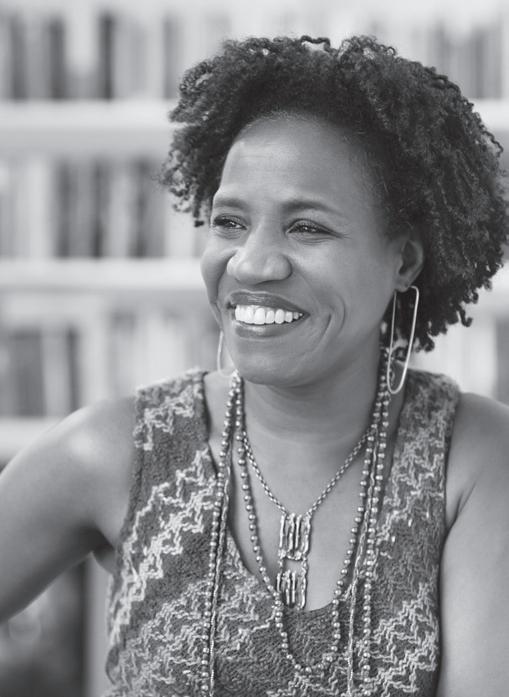

In her lecture, Campt will present work-inprogress from her latest book project, Art in a Time of Sorrow, which tells the story of how, in the midst of the pandemic, writing about art became a survival tactic that helped her grapple with intense experiences of personal grief during a period of pervasive social grievance. The talk will explore how Black contemporary artists create artworks that speak beyond what we see and give expression to the absent presences that constitute some of the most palpable manifestations of grief and mourning.
Tina M. Campt is Roger S. Berlind ’52 Professor of Humanities in the Department of Art and Archeology and the Lewis Center for the Arts at Princeton University. She is a black feminist theorist of visual culture and contemporary art and lead convener of the Practicing Refusal Collective and the Sojourner Project, as well as a founding scholar of Black European Studies. Campt has published five books including her latest monograph, A Black Gaze: Artist Changing How We See (MIT Press, 2021). She received the 2020 Photography Catalogue of the Year Award from Paris Photo and Aperture Foundation for her co-edited collection, Imagining Everyday Life: Engagements with Vernacular Photography (with Marianne Hirsch, Gil Hochberg and Brian Wallis, Steidl, 2020) and the 2024 Photographic Studies Award from the Royal Academy of Anthropology.







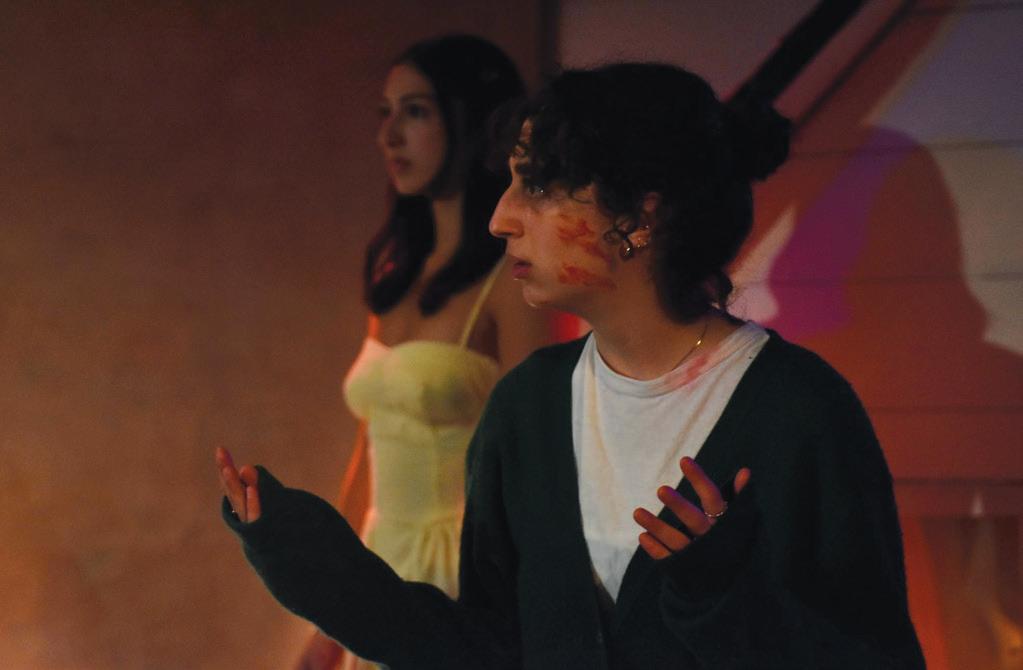
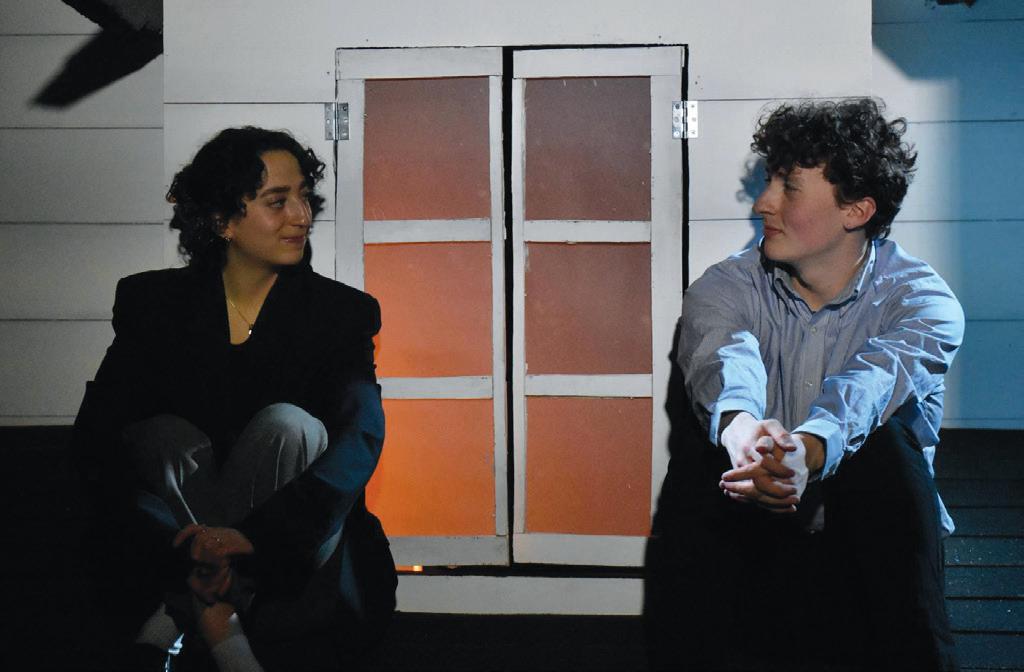

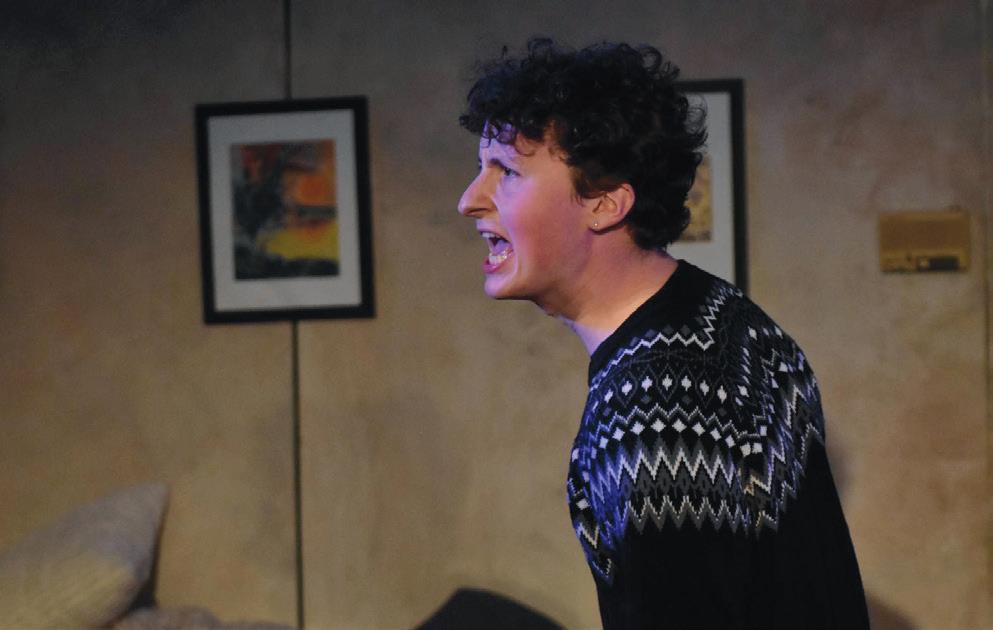

By KATE POLLOT
the daily northwestern
@kpollot47452
Content Warning: This story contains mentions of suicide.
At 5 p.m. on Tuesday, Vertigo Productions released tickets for its spring play “CRAVE; or how to freeze the phantasmagoria.” Two minutes later, all four scheduled performances were sold out.
Performed at Shanley Pavilion April 18 and 19, “CRAVE” was written by Communication senior Lola Bodé. She wrote the project last year as part of her advanced playwriting sequence, a year-long class that allows students to develop a play.
Bodé said she wanted to do something outside of her comfort zone: a horror show.
Her finished product, “CRAVE,” draws on the ethics of incorporating real people into fictional work and Bodé’s experience navigating a breakup.
“As I was writing, these feelings of grief and loss were seeping into the play in ways
that felt bigger than just a broken relationship,” Bodé said. “It became more of a meditation on how we confront those feelings.”
“CRAVE” follows three characters: Maeve (Communication senior Dahlia Trilling), Charlie (Communication senior Abraham Deitz-Green) and Anna (Communication sophomore Mila Levit), Maeve’s best friend and Charlie’s girlfriend. The show begins after Anna’s death, at the end of her funeral.
A few years later, Maeve appears at Charlie’s apartment in New York City, the pair having not spoken since Anna’s death. An enraged Maeve has discovered that Charlie has written a memoir about the trio and planned to publish it without telling her.
The show shifts between the past and the present, the written and the imagined; and sometimes, it’s hard to tell which is which.
As the cast reenacts what Maeve reads in the memoir, the audience learns more about the trio’s relationship and Anna’s mental health.
Anna, a writer who wrote exclusively in red pen and admired the sun, died by suicide. The show’s horror elements manifest in her ghost.
She haunts Charlie’s apartment as he writes the
memoir, making herself known through the flickering lights and locked doors.
“While Anna was trapped in Charlie’s apartment and haunting him, she was trapped in what felt like artificial light,” Bodé said. “All that she wanted was to be natural and bigger than life and be the sun, and yet she was being trapped in this artificial manifestation of what that looked like.”
Communication freshman and Technical Director Seidy Pichardo helped lead the show’s stage crew efforts. Working with the show’s scenic designer, Pichardo led a team to create the set, which included Charlie’s apartment and the rooftop.
“It takes an army to bring something as beautiful as ‘CRAVE’ to life,” Pichardo said. “Everyone in this process is so talented and an expert in their craft.”
One such team member was Communication sophomore Madison Anderson, the show’s producer.
Anderson worked with Bodé and Communication senior and Director Talia HartmanSigall to select designers for “CRAVE.”
“This was such a fulfilling process for me.
I got to facilitate conversations between so many different people and just be the middle ground and liaison for all of these different elements that were put into the show,” Anderson said.
Bodé said “CRAVE” features “young people at a transitory time in their life” who are “trying to cope with something that feels beyond them,” making it applicable to a college audience.
Communication freshman and Vertigo member Creighton Smith-Allaire helped build the set. He said he found the flickering lights that indicated Anna’s presence particularly memorable.
However, Smith-Allaire also took away a greater message related to the way in which Charlie and Maeve grieve Anna from the show.
“These people who are gone, we each remember them differently, but we remember them best when we unite and remember them together instead of choosing how we want to remember them,” Smith-Allaire said. katepollot2024@u.northwestern.edu
By MAYA WONG daily senior staffer @mayaw0ng
A&O Productions hosted comedian and actor Devon Walker as its spring speaker in Lutkin Hall Wednesday night. In a stand-up set and Q&A, Walker discussed his career journey, comedy inspiration and life in the public spotlight. Walker is best known for his role as a repertory cast member on “Saturday Night Live,” which he joined in 2022. Walker recently went viral for his appearance as an interviewee on SNL’s Weekend Update, where he shared a morning routine mocking the elaborate and expensive daily regime of the “Saratoga Spring Water guy.” In addition to SNL, Walker has written for shows like “Big Mouth” and “Everything’s Trash.” Walker’s appearance was preceded by a screening of the SNL-based film “Saturday Night,” a comedy-drama documenting SNL’s first episode in 1975. A&O’s Head of Speakers and Medill senior Elizabeth Casolo said A&O’s speaker committee tries to partner with the
club’s film committee every year for the spring speaker event.
“We were thinking of people who would be in our budget and would really speak to the Northwestern audience, but also have some sort of film or TV tie-in,” Casolo said. “We decided to look into options (around SNL) because the movie ‘Saturday Night’ recently came out and we thought it would be a really good tie-in.”
A&O has previously hosted SNL cast members for its speaker events, including Sarah Sherman, Bowen Yang and Chloe Fineman.
After the “Saturday Night” screening, Walker took to the stage to perform a stand-up comedy set. He began with an explanation that he’s never seen “Saturday Night” because he himself had auditioned for the movie and was not cast.
“I couldn’t watch it. I can’t re-enter that stress,” Walker said.
Walker went on to recount his experiences since he joined the SNL cast. He joked his father suddenly began visiting him in New York despite living there for five years before and Mick Jagger locked him out of a 30 Rock bathroom — much to Walker’s dismay, he said, as he thought it would be cool to use the restroom
at the same time as the Rolling Stones icon. Walker also joked about the sexual tension in NBA fights and watching them thinking, “they should kiss.”
Walker’s jokes were met with palpable laughs. He noted toward the end of his performance that this was his “college set,” and some jokes — specifically the NBA kissing one — didn’t sit well with more conservative audiences.
Walker’s 30-minute set was followed by a Q&A moderated by Communication junior Leela Malladi.
Malladi’s questions focused on Walker’s experience auditioning for and being on SNL. Walker said he auditioned for the show with two stand-up comedy sets, unlike most cast members, who do impressions. He debunked the myth that the judges at SNL’s second private audition aren’t allowed to laugh — because he got laughs, himself.
“Doing stand-up is really cool because it’s whatever you want,” Walker said. “And then when you’re working with the show, you have to kind of find that balance between what you like and what the show likes.”
Walker said since being on SNL, his favorite sketch characters he’s played are Golden
State Warriors forward Draymond Green and lactose intolerant British rapper Shirty, from Milly Pounds and Shirty.
As for his goals for the future, Walker said he hopes to get to a place where he can help his friends make connections in the industry, creating opportunities so that his friends can hopefully get to where he is now.
Weinberg sophomore Shreya Rallabandi, who sat front and center in the audience, said she has been a fan of SNL for a while and Walker is one of her favorite rising stars.
“I honestly really liked the Q&A, because that was all new,” Rallabandi. “It was really nice to hear how he’s just naturally funny.”
Casolo said she hoped attendees left the speaker event with not only laughs, but a bit of life advice.
Walker’s two cents?
“Always try to find the thing that feels really specific to you. Always try to find the thing that feels like it couldn’t have come from anyone else,” Walker said. “Also try to watch for what you don’t like in the industry and really try to make sure you’re not doing that.”
m.wong@dailynorthwestern.com
By MAYA WONG daily senior staffer @mayaw0ng
When Medill sophomore Mila Brandson arrived at Northwestern her freshman year, she knew she wanted to join a dance group. Her mother was a former professional dancer and Brandson herself practiced ballet all her life.
Yet, when looking at the dance club offerings on campus, Brandson didn’t feel like her background in ballet matched any of the groups. Her friends Communication sophomore Yitong Zhang and SESP sophomore Morgan Dreher felt the same way.
“We were pretty dissatisfied with the options for us on campus, since we all came from that same ballet training background. We want to create a space where we can actually continue dancing and training at that higher level and feel challenged,” Brandson said. “We felt like there was just a gap in offerings.”
During winter quarter of their freshman year, the three friends decided to take matters into their own hands: The seedlings of Reflections Repertory
Company were planted.
At the time, the only classical ballet dance troupe on campus was Eight Counts Ballet Company, which focuses on offering accessible beginner-level ballet classes to students.
“Reflections just filled a niche that wasn’t filled when we got on campus,” Zhang said. “(Eight Counts) was barrier-free and maybe not as intensive of a level as we were used to.”
After working out the logistics for Reflections, the friends filled out a club application form last May. The following summer, they assigned executive board roles — Brandson as marketing director, Zhang as artistic director and Dreher as executive director — and prepared the dance company for its first round of auditions to build a base of dancers.
Weinberg freshman Emma Christensen auditioned for Reflections during the company’s first auditions last fall.
“It was a very smooth process for me,” Christensen said. “Normally, I feel like I get a lot of jitters about auditions, but I immediately felt so welcomed by the girls and the environment was just so great right from the start.”
Reflections Repertory Company’s main style
of dance is contemporary ballet. Its dancers are trained in classical ballet, but Reflections’ style builds upon these technical foundations to have a more modern twist. The company also performs numerous contemporary pieces, as well as the occasional hip hop or jazz dances.
Reflections offers different levels of commitment for both beginners and seasoned dancers. Its open division is for more casual dancers who want to attend the occasional classes. The performance division, on the other hand, is audition-based. Those in this division rehearse weekly, perform in the company’s winter and spring shows and have opportunities to choreograph pieces on their own.
For those seeking a more rigorous ballet schedule similar to what they experienced growing up, Reflections’ performance division has created the community they were looking for.
“We’ve been getting to know all the girls in the company, because they’re people I otherwise probably would not have known,” Christensen said. “It’s just been so great, especially getting to know the upperclassmen who have kind of been like older sisters to me.”
But founding a dance troupe has not come without its difficulties, Brandson said. She and her
co-founders had the most trouble with the learning curve of essentially starting and running a business from the ground up.
With funds being necessary to bring in guest choreographers, hire lighting designers, pay for company costumes and more — Reflections needed money. The club managed to get most of its funding from ASG grants.
“It was a little bit hard to find avenues for funding this year, but we definitely scraped up as much as we possibly could,” Brandson said.
Since its inception, Reflections has performed in New Movement Project’s fall dance concert, Evanston Light the Night and its own winter show, titled “Sparks Fly.”
For the rest of Spring Quarter, the company’s docket is full. Reflections will host its spring show this quarter, and it plans on guest performing at Refresh Dance Crew’s spring show on April 26 and Unity Charity Fashion Show on May 8.
“It’s been really special being able to create something of my own,” Zhang said. “Shaping a new community and then creating it both for ourselves and for other people has been really nice.
m.wong@dailynorthwestern.com
‘Black Mirror’ is bleak, delightful and smartly sentimental
By YANA JOHNSON the daily northwestern
This article contains spoilers. There was a time, nearly half a decade ago, when the future of “Black Mirror” was as opaque as its name.
Amid the constant violence, illness and injustice of 2020 — Charlie Brooker, creator of the series, expressed a disinclination towards more tales exposing the wicked underbelly of the modern human condition. Reality was nightmarish enough.
But even in these arguably bleaker times, “Black Mirror” remains at its best when it’s emotionally scarring. After two seasons of middling quality, the British anthology series seems to finally have regained its color in a deeply emotive seventh season. All six new episodes released April 10 on Netflix.
In keeping with prior installments, there is no shortage of fear injected into these fresh “Black Mirror” episodes. Recurring themes of the show have included the dangers of technological expansion — particularly the over-involvement of technology in human life and interactions — and the new batch of episodes are no different. It’s an easy
fear to capture in a world in which computers become more intelligent and essential by the day, and Brooker exploits this fear onscreen superbly.
In a deviation from other seasons, however, this season is lassoed together by the weighty rope of human emotion and intimacy — especially love.
The notion that perhaps the show’s nanotech heart beats after all is a revelation, and it makes the best episodes of this season sing.
One such standout episode is “Common People.” Amanda (Rashida Jones) and Mike (Chris O’Dowd) are a lovable, working-class couple struck by tragedy in the form of a brain tumor. Distraught and desperate, Mike is approached by Gaynor (Tracee Ellis Ross), a brand representative who encourages him to purchase Rivermind, a company that can offer Amanda a synthetic brain implant and enable her to live a normal life — on a subscription basis, of course.
The commentary on the exploitative nature of subscription services is a touch heavy-handed, particularly for a show airing on a subscription-based streaming service that has itself been accused of greedy, exploitative tactics. Still, that doesn’t dull the gut punch of watching the couple fall victim to the predatory system they sought for help.
When Mike mercifully kills Amanda before
sulking offscreen to his own ambiguous fate, “Black Mirror” does what it does best: It hurts.
In “Common People” as with other episodes, the emphasis on love proves to be the strength of this season. In “Eulogy,” Paul Giamatti stars as a bitter recluse with an external brain chip that enables him to walk through memories of the relationship he attempted to forget — making a beautiful, heart-wrenching meditation on love, regret and loss. Giamatti’s performance is warm and endearing, perfectly complementary to a story that is less punishing than it is poignant.
“Hotel Reverie” completes the trio of love centered episodes. The story stars Issa Rae as Brandy Friday, an actress starring in a tragic love story with Emma Corrin’s Dorothy Chambers in an AIgenerated renewal of a classic film. Rae and Corrin are magnetic, and even Awkwafina is bearable as the director of the AI film’s chaotic situation room. Corrin’s transformation into a closeted, fragile, noir film star, is merely a hair’s breadth from Giammati’s as the series’ most emotionally stirring performance.
Of course, not every episode is perfect from beginning to end. “Bête Noire,” in which a woman becomes convinced that her new coworker has reappeared from the past to sabotage her in
increasingly insidious ways, is humorous, wellpaced and delightfully tongue-in-cheek, but lacks the depth other episodes offer and cheats itself of victory at its third act’s finish line.
“Plaything,” which stars Peter Capaldi acting his heart out, is a visual treat. The scenes in which the eccentric gamer-turned-murderer trips on acid to communicate with a digital lifeform are intoxicatingly vibrant and alive. Tragically, it is in stark contrast to the plot, which feels the stalest and least relevant of the six episodes. The “USS Callister” sequel, “USS Callister: Into Infinity,” is similarly almost too uninspiring to waste words on.
That “Black Mirror” manages to stay relevant fourteen years after its premiere is in itself a feat. It remains impactful and is effective at stirring fear, desire and sadness in the hearts of its viewers, making it doubly impressive.
In another ten years, life may once again be too bleak for another installment of “Black Mirror;” or, one of the show’s nightmarish technology scenarios may finally come true. But in the meantime, “Black Mirror” spooks while staying sincere, reminding viewers why it has stood the test of time.
yanajohnson2028@u.northwestern.edu
By CLARA MARTINEZ the daily northwestern @claramart1nez7
The amps are dialed up, condensation drips from cups and cans and the crowd squints against the sun to see student band Tavern take the stage. The stage –– in the case of the band’s first performance as freshmen –– being an elevated wooden platform in the backyard of an off-campus frat house.
As the opening chords of Gnarls Barkley’s “Crazy” reverberated through the crowd, few would’ve guessed that Communication senior and lead singer Annie Wallach suffers from stage fright.
“The party was happening, and now everything’s gotten real quiet,” Wallach said. “I was like, ‘This is super awkward.’ But once it picked up, people got really into it.”
After their first performance, the band became a staple at off-campus parties in the musicians’ sophomore and junior years, expanding their set
list to include both new arrangements and original songs. Now, with graduation on the horizon, the band prepares to play its final set in May.
In Spring 2023, the group achieved perhaps the greatest feat for a student band. After winning Mayfest’s Battle of the Bands, they played the main stage on Dillo Day — the nation’s largest studentrun music festival.
The idea for the band began when Wallach and Communication senior and guitarist Phoebe Feldman struck up a conversation outside of the Ridgeville Tavern when discussing their shared interest in music.
After a few duet jam sessions of Feldman playing guitar and Wallach singing, Wallach said they started to throw out ideas to create their own arrangements of songs with drums, bass and brass.
“Slowly we were like, ‘Why don’t we just find other people to play with who have those things so that this could sound as good as it can?’” Wallach said.
The pair began reaching out to other freshmen musicians, many of whom were also already

hosting jam sessions in Bobb Hall.
Weinberg senior and guitarist Coby GrantKrenz recalled that the band began rehearsing in the basement of Lindgren Hall –– an old frat house that became a dorm –– where another student band had been storing their drum kit. Grant-Krenz said the other band let them use the drums and space to practice for their first performance.
“It was a (Zeta Beta Tau) darty, and I’m sure that the sound quality was just awful, like we had the bare minimum gear,” Grant-Krenz said. “But we got out there and played, and the crowd was having fun.”
They picked a setlist of crowd pleasers for the first gig, including “Valerie” by Mark Ronson ft. Amy Winehouse and “Locked out of Heaven” by Bruno Mars.
Yet, Wallach said she never anticipated that jam sessions beginning in Bobb would ever have an audience. Her musical experience included singing in her high school Glee Club, but she said she had almost no performing experience before Tavern.
When it came time for their first performance, Wallach and Feldman threw out the name Tavern.
“It wasn’t like a conclusion in the moment,” Grant-Krenz said. “But everyone was like, ‘Yeah, that’s cool.’ And then it stuck.”
As a close friend to a few of the band members, Weinberg senior Lia Tunney was a regular in the crowd as the band was taking off.
She said the musicians had friends in different places, and that their combined support gave the band the traction they needed in the early days to reach a wider audience.
Compared to the past couple of years, GrantKernz said Tavern’s focus has shifted to jamming more casually and playing gigs as the band prepares to graduate and leave college life behind.
“Sophomore year specifically, there was just this constant grind to continue to play concerts, and now senior year, I feel like we’re more laid back,” Grant-Kernz said. “I guess it’s just a shift in perspective.”
The band has also ventured into playing
at professional venues like Evanston SPACE, although Grant-Kernz said the group is probably going to play another backyard show before the end of Spring Quarter.
Grant-Krenz has produced music while at NU and said he plans to continue after graduating. However, he said the members of Tavern will be scattered across the country, bringing an almost certain end to four years of collaboration.
“Part of life is having some things come to an end,” he said. “I’m really just glad and grateful that this experience happened.”
Even though it doesn’t appear that Tavern will remain together after graduation, Wallach said the experience was worth every rehearsal and helped her get comfortable in front of a crowd.
“It’s given me a new sense of confidence, and I’ll take that with me everywhere I go,” Wallach said. “But, I don’t picture myself singing after school in a band unless it’s this one.”
claramartinez2028@u.northwestern.edu

DEATH TO ISRAEL. INTIFADA NOW!
Early Monday morning, these words were smeared onto the steps of University Hall and The Rock, hours after I departed a traditional Passover celebration at Hillel. On my admissions tours, I refer to this area of campus, adjacent to Kresge, as “the epicenter of free expression at Northwestern.”
Among the symbols discovered on our university’s oldest building were a series of red handprints. Once painted on the homes of Jews in Baghdad before the Farhud pogrom in 1941, these hands were more famously pictured, bloodstained, after the lynching of two IDF reservist drivers during the Second Intifada in 2000. If you look up “Intifada Red Hands” and click “Images,” it is the first result.
The Daily Northwestern, perhaps the most reliable and respected source of news on campus, called these images “modern symbols of calls for a ceasefire.”
Calling for Intifada (“uprising” in Arabic) is, if not explicitly calling for violence, certainly condoning its inevitability — against supporters of Israel, but more importantly, the Jews who will be targeted by racial association.
The Second Intifada saw the deaths of thousands of Israelis and Palestinians. Supporters of Intifada do not see the end of the Israeli-Palestinian conflict as a two-state utopia. They see it as the destruction, not only of the Jewish state, but, in effect, the people who live there.
Calling out the Israeli government for the suffering they have inflicted on Palestinians in recent years is not in itself antisemitism, as Trump officials would have you believe. Defying the Zionist orthodoxy that
dictates Israeli Prime Minister Benjamin Netanyahu’s worldview is necessary — if the Jewish state is to endure as the only Westernized liberal democracy in its region.
But sentiments that advocate for violence against Israelis do target Jewish students. You may say that anti-Zionism is not antisemitism. That the Israeli government, not Jews, have made the state illegitimate. But if you are operating in good faith, truly, then you must also understand the fine line between those two trains of thought.
Israel, its legitimacy and acceptance on the world stage, is fundamental to the Jewish religion as it has been practiced after the Holocaust. Whether or not Israel “speaks for you” doesn’t matter much when you’re Jewish — its flag is the only that bears our identifier, the Star of David.
Republicans have discovered a new way to practice antisemitism, no doubt — a manipulation of Jewish fears in pursuit of the unrelated goals of dismantling the freedoms and credibility of our nation’s top liberal universities. Many victims of this new form of antisemitism, friends of mine, have even been convinced to defect from the Democratic party entirely — if not in elections, then certainly in message and rhetoric.
I do not believe Democrats are antisemites. But it is time to admit that there has emerged a sense that, in modern progressive identity politics on college campuses, “Jews don’t count.”
The idea comes from British comedian David Baddiel who, in his book of the same name, frames the concept in the context of the UK Labour Party’s antisemitic history, calling out progressive movements for their differing standards on antisemitism relative to other forms of hate. Baddiel argues that due to existing prejudices against Jews, perceptions of wealth and skin tone, progressives seldom treat antisemitism as seriously as racism or sexism.
Last week, the Trump administration brought
the question at the heart of Baddiel’s thesis to our campus, froze $790 million in funding over the University’s response to antisemitism. The news sparked outrage from my professors and peers — it is a flagrant violation of the intellectual integrity and freedoms institutions like ours are built upon, and it was done blatantly to curtail anti-Israel speech protected by The Constitution.
The consequences of this freeze on research will be far-reaching as examined extensively by The Daily. News of continued funding for projects impacted by stop-work orders last week is promising, indicating that the University intends to defy at least the most blatant overreaches of Trump’s government.
But this Passover, my second at Northwestern, a kind of cognitive dissonance set in — between my free speech inclinations and the apathy toward antisemitism that exists in this campus community.
The awkward silence on this campus is striking. Perhaps because the graffiti was removed before anyone could see it, it’s almost like it never happened. I guess we must give the University credit here.
Today, I am articulating a sentiment that many feel they shouldn’t raise outside Jewish circles: something has happened at this university to make this place a target for antisemitism.
Nearly nine in 10 Jewish Americans reported an increase in discrimination since Hamas’ Oct. 7, 2023 attacks. Like those who inadvertently emboldened Trump by spending their time protesting Joe Biden and Kamala Harris last year, elite universities have let Trump win by failing to see what is right in front of them.
Doubling down on the rights of students to espouse antisemitism while failing to contain its inevitable violence — this is a lose-lose strategy, sans $790 million, in which Jewish kids are made to feel like collateral damage in a fruitless political maneuver.
To do everything in your power to prevent antisemitic vandalism is not to surrender to Trump. In fact, it would make the claims he levies against us all the more illegitimate.
I am not a single-issue voter on Israel. Like many of my peers who participated in the encampments last spring and continue protesting to this day, the endless slaughter of Palestinians in Gaza strikes at my very humanity. I desperately want the killing to stop and condemn the deportation of students who exercised their right to protest against it.
But if your humanitarian movement only condemns hatred when it is convenient to your cause, count me out.
This week, our campus was a victim of antisemitism. We wanted information, and our university hid it from us. Once we had it, our news sources gave it to us so devoid of historical context, it appeared whitewashed.
The breaking news story in The Daily should have been a photo gallery. The words on the steps in the subject line of President Schill’s email.
Today, we have a choice — to choose outrage over apathy. Outrage at how we’ve allowed the extremes to bully us. Outrage at those in our politics who seek to use these issues as leverage in a larger experiment in vengeance.
But outrage, first and foremost, at the way one particular minority group has been made to feel othered here. We must take the fight back from those who seek to co-opt it. If we choose apathy today, we will lose — electorally, wherever you stand, and, indeed, morally.
Aidan Klineman is a Medill sophomore. He can be contacted at aidanklineman2027@u.northwestern.edu. If you would like to respond publicly to this op-ed, send a Letter to the Editor to opinion@dailynorthwestern.com. The views expressed in this piece do not necessarily reflect the views of all staff members of The Daily Northwestern.

There has been and will continue to be much written and said about the legacy of Pope Francis. But, as I sit here in my office at the Sheil Catholic Center at Northwestern, still overcome with emotion at the loss of my spiritual father and our Pope, I think Pope Francis would want me to say it has never been about him.
It has always been about God, and reminding the world who God is for everyone.
Pope Francis constantly came back to the mantra throughout his pontificate that the style of God is closeness, compassion and tenderness. Throughout his ministry as the successor of St. Peter, Pope Francis witnessed these truths about God repeatedly through action and preaching.
They aren’t necessarily profoundly theological at all, but through these lenses Pope Francis rehumanized the Catholic Church and its relationship with a world in need of healing. Yes, he has written profound encyclicals and, in many ways, showed us a new way of living the papacy, but above all he has challenged the Church to reembrace our missionary identity.

I’m out dancing with my girlfriends; we’re laughing with our eyes closed enjoying the music when I right my head, open my eyes and see a cute guy — shoot — we’re making eye contact. Pretty soon, his group of friends is approaching mine. We’re still making eye contact but it’s totally flirty now. Then, we’re just regular flirting and his thumb clicks on his phone. He looks down at it before looking back at me and asking, “Can I get your Snap?” Snapchat, the social media platform known colloquially as Snap, is kind of a giant bother. When I was in middle school and it was becoming big, yeah, I was totally into the filters and sending pictures to my friends. But when a guy asks for my Snap? It’s an
For me, the moment he stepped out onto the loggia of St. Peter’s Basilica in 2013, bowed his head and asked the world for our blessing, I knew this would be different. And from the beginning, it has been different.
His choice to forgo the papal apartments for a simple suite at the Casa Santa Marta wasn’t just a gesture of humility, but a reminder to all of us that we are made for community, journeying together. His embrace of migrants around the world, lunches with the homeless, washing the feet of prisoners — each moment underscored a different kind of papal power, one that flows not from the power of office, but from closeness to “todos, todos, todos!”
The closeness which Pope Francis sought to have with people wasn’t about proximity, it was in understanding their lives, their struggles, their hurts — especially as it related to their relationship with the Church. Francis summoned the Church to walk alongside one another. He told pastors to be “shepherds with the smell of the sheep.” Get out of the church and get to know your people. Be among them.
Francis placed human relationships at the center of spiritual life, with no need for anyone to fit some mold. Closeness was not to a select group of privileged few. Victims of abuse, the divorced and remarried, young people struggling with the institutional church, those who identify as LGBTQ or atheist
— Francis reached out to all, widening his embrace and calling the Church to do the same.
Pope Francis’ closeness stemmed from knowing a God of deep compassion. This pontificate changed the vantage point of Catholic leaders, encouraging them not to see the world through stained glass, but rather through the eyes of those who are on the periphery and suffering.
Francis turned part of St. Peter’s Square into a refuge for the homeless. At World Youth Day in Panama, he stopped to visit a shelter for those with HIV. Time and again he has witnessed that where there is suffering, the Church must be present. The Church must weep with those who weep.
This was also a constant thread in his writings, especially “Laudato Si’” and “Fratelli Tutti,” which called all people of goodwill to expand their reach of compassion to the poor, the forgotten, the earth and to those with whom we may have differences. The Church is a “field hospital,” Pope Francis often said, and we must provide healing to all without reservation.
But perhaps it is his tenderness, which is the gift which stands out most to me. Tenderness is not often a word used when speaking of leaders of major institutions, yet in his leadership of the expansive Catholic community, it was tenderness that was often witnessed. He knew tenderness personally and sought to invite others to experience it and share it
as well. When asked who he was, he didn’t list his accomplishments. He said simply: “I am a sinner whom the Lord has looked upon.” Such reflections were common in his pontificate, opening doors for so many to understand a God whose very name is mercy. As I reflect on his life and ministry, I am grateful that Pope Francis lived his life as a witness of the God he knew deeply: a God of closeness, compassion and tenderness. For this I give thanks. If that is his legacy, may we all learn from it.
Father Bradley A. Zamora is the Catholic Chaplain and the director of the Sheil Catholic Center at Northwestern. He can be contacted at bradley.zamora@northwestern. edu. If you would like to respond publicly to this op-ed, send a Letter to the Editor to opinion@dailynorthwestern.com. The views expressed in this piece do not necessarily reflect the views of all staff members of The Daily Northwestern.
The Daily Northwestern Volume 149, Issue 3
Editor in Chief
Lily Ogburn
Opinion Editor Eli Kronenberg
Assistant Opinion Editor Gabe Hawkins
immediate brownie points dock.
For starters, I hate the app. I still use Snap, I have to — between the active group chats and major life updates communicated through private stories, I’d be missing out on a ton of crucial social interactions with my peers if I didn’t.
But, the reason Snapchat is so useful is also kind of a burden. Knowing what my peers are doing constantly, especially when I was younger and more self conscious of my social calendar, can lead to a lot of FOMO. Ergo, I do not want to communicate through Snaps.
It’s more than my general distaste towards Snapchat, though. When a guy asks for my number, it feels like there’s more intention there. He’s going to text me asking me on a date, not send a picture of him smirking. It’s so much more mature. There’s also something sexier about asking for someone’s number than their Snap. Watch any great rom-com, nobody is being asked for their Snaps. Sure, most of them came out before Snapchat existed, but that doesn’t change the fact that babes
throughout history have been asked for their numbers. It just sounds right.
I don’t often feel this way, but when it comes down to it, between asking for numbers and Snaps, I really think we need to stay in the past. Communication back then seemed more down to earth and romantic. I want to be lying on my bed twirling my landline cord while speaking to a boy I’m into, like a person; not sending selfies back and forth like robots.
That might be a little extreme. I don’t need to be called to be asked out or whatever — plain old text messages are vintage enough. Just please, if you see me out with my girlfriends and want to make a move on me, don’t ask for my Snap.
Sylvie Slotkin is a Medill sophomore. She can be contacted at sylvieslotkin2027@u.northwestern.edu. If you would like to respond publicly to this op-ed, send a Letter to the Editor to opinion@dailynorthwestern.com. The views expressed in this piece do not necessarily reflect the views of all staff members of The Daily Northwestern.
Managing Editors
Misha Manjuran Oberoi
Danny O’Grady
Anavi Prakash
David Samson
Leah Schroeder
Shreya Srinivasan Jerry Wu
LETTERS TO THE EDITOR may be sent to 1999 Campus Drive, Evanston, IL 60208, via fax at 847-491-9905, via e-mail to opinion@ dailynorthwestern.com or by dropping a letter in the box outside The Daily office.
Letters have the following requirements:
• Should be typed and double-spaced
• Should include the author’s name, signature, school, class and phone number.
• Should be fewer than 300 words
They will be checked for authenticity and may be edited for length, clarity, style and grammar.
Letters, columns and cartoons contain the opinion of the authors, not Students Publishing Co. Inc. Submissions signed by more than three people must include at least one and no more than three names designated to represent the group.
Editorials reflect the majority opinion of The Daily’s student editorial board and not the opinions of either Northwestern University or Students Publishing Co. Inc.
By CASEY HE daily senior staffer @caseeey_he
Evanston could soon begin offering financial assistance to long-term residents under a program City Council is currently considering.
The proposed Property Tax and Rent Circuit Breaker would subsidize property tax or rent for some longtime residents facing housing burdens, said Ald. Clare Kelly (1st), who referred the proposal to City Council in February.
“Many people are chanting the mantra of ‘build affordable housing’ without expressing equal concern for protecting our long-term residents here who are low-income,” Kelly said. “So I really challenge everybody who’s coming out to say, ‘build more affordable housing,’ who aren’t in the same breath concerned about affordability in Evanston and those who are being displaced.”
While much of the program’s scope still hangs in the balance — Kelly said she needs more data and analysis to finalize the proposal — it will likely apply to those who have lived in the city for more than 20 years and fit yetto-be-determined income and housing cost thresholds.
The funding sources for the program are likewise undecided, though Kelly said the proposal aims not to raise property taxes. The February referral submitted to the city identified three potential sources: the affordable housing funding from Northwestern, sales tax from the new Ryan Field and real estate transfer tax from homes that sell for more than $1 million.
Kelly said the proposal came out of a collaboration with resident and community activist Meleika Gardner. The debates around Envision Evanston 2045 — the sweeping zoning and policy overhaul that has become a flashpoint in city politics — catalyzed the proposal, she added. She said the comprehensive plan gives little consideration to slowing the displacement of current residents.
Gardner, who founded and produces videos on Evanston politics at Where The People Meet TV, said concerns from longtime residents struggling to stay in the community inspired her to pursue a local circuit breaker program.
“In listening to the community over the past decade, one of the top things I would always hear about is people feeling like they can’t afford to age in place here, and that was the plan,” Gardner said.
Since last year, Kelly and Gardner said they have met with residents, community stakeholders and staff members at Cook County’s Assessor’s Office to gather input and data.
Cook County currently offers several forms of property tax exemptions for long-term and senior homeowners. A senior exemption reduces the taxable value of homes by $8,000 for homeowners over 65 years old. A separate “Senior Freeze” program would freeze a home’s taxable value if the homeowner is over 65 and has a household income of $65,000 or less.
About 350,000 homeowners receive the senior exemption, and 130,000 receive the annually renewable Senior Freeze exemption, which is designed to help seniors on fixed income to afford rising property taxes, a spokesperson from the Assessor’s Office told The Daily.
The Illinois General Assembly is also considering a statewide circuit breaker program backed by Cook County Assessor Fritz Kaegi. Under the program, homeowners who saw their property tax bill increase by 25% or more year over year may be eligible for a grant to cover up to half of the tax spike.
However, Kelly and Gardner said existing programs remain inadequate for Evanston residents. Few Evanston homeowners qualify for the income-restricted Senior Freeze program and none specifically support renters, they said.
When the Evanston circuit breaker proposal came before the city’s Finance and Budget Committee at its March meeting, it received ringing endorsements from several residents during public comment.
In light of potential cuts to federal Department of Housing and Urban Development programs like Section 8 housing vouchers, Evanston resident and landlord Tina Paden said the local program would provide critical aid to low-income residents.
“We must push for the program to get the attention and so that it can go forward,” said resident and recent 2nd Ward council candidate Darlene Cannon at the meeting. “Let’s stand

together to keep Evanston livable for everyone.”
But some members of the finance panel appeared skeptical of the proposal. Business executive David Livingston said that as the city’s general fund is in a deficit, the circuit breaker’s funding would likely have to come from budget cuts or an additional property tax levy. Ald. Bobby Burns (5th) also said the discussion around the proposal should be incorporated into the city’s Strategic Housing Plan.
Three councilmembers, Alds. Thomas Suffredin (6th), Eleanor Revelle (7th) and Devon Reid (8th), signed on to Kelly’s original proposal. But with only Suffredin slated to return to office — Revelle has retired from her seat, and Reid lost his reelection bid in the April 1 election — Kelly said she plans to resubmit her referral for the proposal, potentially with
support from one of the freshman councilmembers, in the coming weeks.
For Gardner, the circuit breaker program goes beyond a subsidy for Evanston’s neediest residents. Talk of affordable housing often conjures up images of poor families of color who rely on housing vouchers yet misses the fact that residents from all backgrounds and even those of middle income are now being priced out of the city, she said.
“We need housing that people can actually afford, and until we figure that out, let’s help the people who have been here for decades,” Gardner said. “That’s what I thought Evanston is. It is that kind of community that really looks out for each other.”
c.he@dailynorthwestern.com
G e t a h e a d , c a tc h u p, t r y s o m e t h i n g n ew.


By YANA JOHNSON the daily northwestern
Northwestern’s South Asian Student Alliance hosted its annual Holi celebration on the Lakefill Saturday. More than 100 SASA members and others celebrated the occasion by donning white shirts and slinging colorful powders through the air at friends, partners and strangers alike.
Holi, also known as the Festival of Colors, is a Hindu holiday commemorating love, rebirth, rejuvenation and the beginning of spring. It is commonly observed in India, Nepal and other South Asian countries around early March. However, SASA celebrates later in the year to accommodate for the weather. Holi is often celebrated with religious ceremonies or by joyously throwing colored paint and water.
Weinberg sophomore and SASA co-President Aarav Raina explained the joyful significance of the holiday shortly before the oncampus celebration commenced.
“It’s a time where people get to really let loose and have fun with their loved ones,” Raina said. “And not have to care about their appearance or anything, and just live in the moment and celebrate this beautiful festival.”
Students passed dozens of boxes of popular Indian mango-flavored juice Frooti and repurposed the calm waves of Lake Michigan for water gun ammo while speakers blasted popular South Asian hit songs.
As students pelted each other with powder, white shirts melted into green, red, blue, orange, yellow and purple. McCormick sophomore Aadya Wijesekera called the colored powder play her favorite part of the event.
“I’d say the most fun part is the powder,” Wijiskera said. “Everyone is throwing powder at each other, even if you don’t know the person.”
Strangers also connected at SASA’s Holi celebration. Many students who were not of South Asian descent or affiliated with SASA came to the Holi celebration to join their South Asian friends, or simply out of curiosity.
Weinberg sophomore Meadow NeubauerKeyes attended the celebration at the invitation of a friend, who themself was encouraged

Many participants described sneaking up on friends and splashing them with paint as the best part of the
by a friend on SASA’s executive board. Neither had ever been to a Holi festival before, but they said they wanted to attend one for the colors and community.
Raina said he enjoyed how Holi is a holiday




everyone can celebrate.
“This is the event that I feel like anyone and everyone is welcome to,” Raina said.
“You’re hanging out with your friends spraying powder on each other. I really welcome
(anyone) for future years not to be shy, and come to a SASA event even if you’re not South Asian.”
yanajohnson2028@u.northwestern.edu














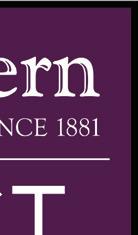














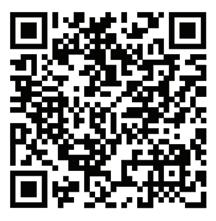

By SARAH SEROTA daily senior staffer @sarahserota
“Fascination” by David Bowie reverberates through the room as customers wander through the aisles of the downtown Evanston store Animal Records, sifting through vinyl records from artists like Janet Jackson to the Grateful Dead.
The walls of the room are adorned in pink and yellow stripes with stuffed animals perched everywhere the eye can see.
Animal Records owner Greg Allen waves to people as they enter his store, greeting regulars every so often with a casual, “How you doing?”
“We’re just trying to keep it a happy, positive place,” he said. “If some people are interested in records, that’s great. But we don’t really care if somebody comes in, even if they don’t buy anything. If they just want to come in and hang out and talk, that’s good too.”
Record stores, once a fixture of the past, have had a resurgence in the greater Chicago area in recent years. Not only are these stores a place to shop, but also a place of community for music lovers.
Helping others search for the perfect sound
Owning a record store is an aspiration for many music lovers, yet only a few dare to take the jump. Allen was one of the few who decided to take a chance on his dream.
Since Allen was a teenager, he had been collecting records, storing about 40,000 records in his house before opening the store.
“It was getting to the point where there were entire rooms where it looked like a hoarder kind of situation,” he said.
Allen opened his store in September, ready to share his love and knowledge of vinyls with the world. The store is mainly composed of used vinyls, many of which he said he collected before opening the shop.
For Allen, the experience of being in the record store and browsing through hundreds of different albums sets the independent record store experience apart from big box stores like Target or an online marketplace like Amazon.
He said that customers can most likely go on Amazon and find a specific record. But independent record stores let customers hold and look at the record, while also offering alternative vinyl.
“You decide you don’t want that one, but you want
one of these other (records),” Allen said.
Specifically, Allen said independent record stores in the Chicago area have established an almost antiquinglike system where they carry a unique collection of records, with only an overlap between the most popular albums, such as The Beatles’ “Abbey Road,” he said.
“One antique shop might have one kind of desk, another antique shop might have a different kind of desk,” said Allen, drawing a comparison between record shops and antique stores. “Are they competing? Maybe not, because the person who wanted the one kind of desk might not be interested in the other kind of desk, right? So that’s the thing.”
Given the wide variety of records, some specific vinyls are particularly challenging to find, according to Evanston’s Squeezebox Books & Music owner Tim Peterson.
At one of his earlier record stores, Peterson said a man came in searching for a 12-inch by First Choice on Salsoul.
“People asked about (the record) from time to time. We never had it in. That moment in time, I had it. I pull it out and show it to the guy. He literally screamed at the top of his lungs, and he just ran out of the store,” Peterson said. “Two minutes later, I saw him running down the street on the other side. And then two more minutes after that, he busted in the door again, and he pulled out his money and bought the record.”
Before Squeezebox, Peterson had owned multiple other record stores since 1996. He said these independent shops are the places that truly excel at helping customers find what they have been after.
Record stores’ staff have a passion for music that can help newer customers who are curious about the varieties of vinyl, or advise the record collector on what album they should try next, Peterson said.
Since Peterson opened his latest record store in Evanston, Squeezebox, back in 2011, he said he has seen a surge in vinyl demand, crediting the COVID-19 pandemic for spurring this spike.
“During the pandemic, things went kind of bananas because everyone was trapped at home,” he said. “Nothing else going on, and they’re like, ‘I’m going to start buying records.’”
Vinyl sets itself apart from the crowd
In recent years, there has been a surge in the number of young vinyl collectors. While some buy vinyls for the aesthetic and novelty, most buyers enjoy the vinyl listening experience, Peterson said.


“My experience is that a handful of young people will have it for the novelty factor,” he said. “For the most part, I would say 98% of our customers are buying because they want to listen.”
Peterson said he saw streaming services as having their own distinct function: guiding music lovers to new artists and albums so they can figure out what they enjoy. With vinyl, however, listeners can fully “settle in” with the music, he said.
Andersonville store Rattleback Records owner Paul Ruffino described vinyl as an intentional process compared to the passive nature of algorithms.
“Part of the experience is having a physical piece of media to hold in your hand and to read the lyrics, which is like reading poetry, or to look and see who are the people playing on the record,” Ruffino said.
Catering to the customers
Ruffino’s intentionality with vinyl is similar to the curated vibe of his store. Sunlight gently streams through the front window of Rattleback, creating a homey, welcoming atmosphere, which was one of the reasons why he said he bought the location in 2018.
Ruffino describes his store best as “fun and full service,” seeking to provide a taste of all genres for its customers.
“We want to make sure that we create a space for people (where) they feel safe and comfortable just asking
us questions, because there’s a lot,” Ruffino said. “In some ways, it’s a very simple format. It’s a vinyl record that you put onto a machine and it plays music. But in other ways, there are some nuances to it.”
Ruffino said cultivating the store also entails creating a community where people can learn and explore music.
For Record Store Day, a semi-annual celebration of independent record stores on April 12, crowds of people flocked to Rattleback Records to celebrate. Ruffino said people lined up at 8 p.m. the night before, setting up camp with folding chairs in front of the store; during the day, he watched a line stretch around the block with people eager to experience all the store had to offer.
“The initial people were here, they were here because they were looking for a very specific release,” Ruffino said. “But over the course of the day … a lot of people just (came) in to support independent record shops and to look for things that weren’t necessarily stuff that was released for Record Store Day.”
These stores have become more than just a vinyl shop, according to both Allen and Ruffino. Vinyl stores have transformed into a forum for music lovers to share their love for albums and artists with each other, Allen said.
“I think (people) come here for the expertise, and also for the experience of just being able to interact with another person who is also here because they enjoy music,” Ruffino said.
s.serota@dailynorthwestern.com





















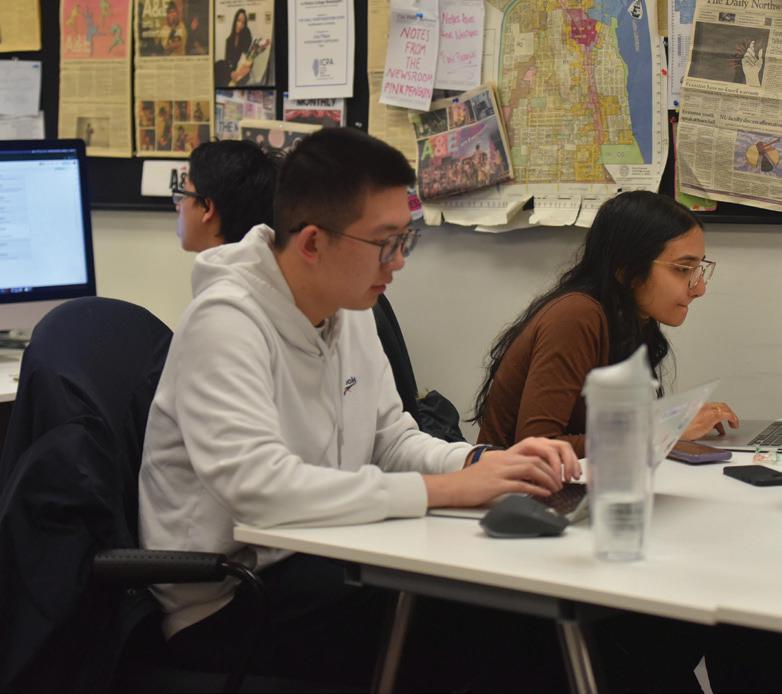







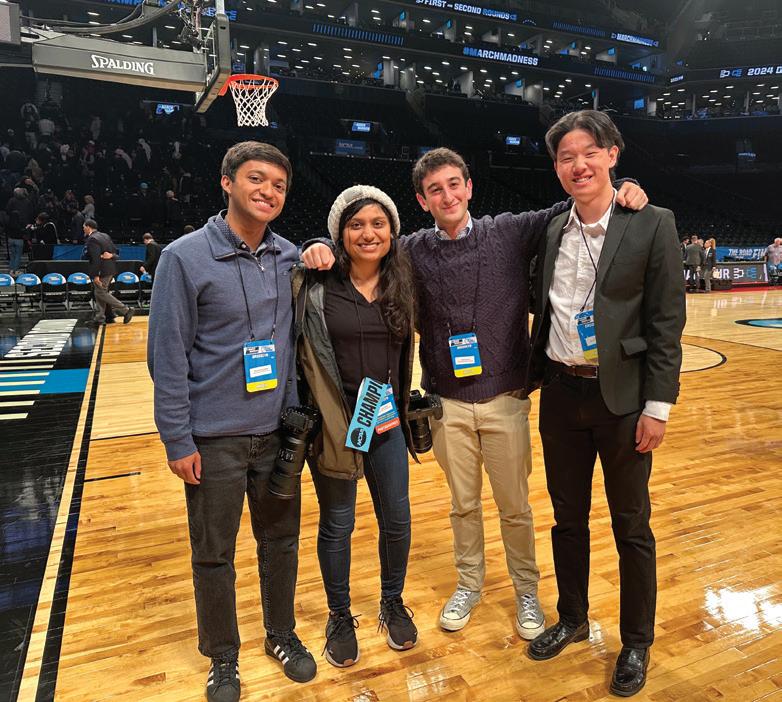


An article published in Wednesday’s paper titled “NU alums, students level the playing eld as through women’s sports journalism” inaccurately stated Northwestern’s women’s lacrosse national championship appearances. ey were in 2023 and 2024. e Daily regrets this error.
By: Kate Pollot











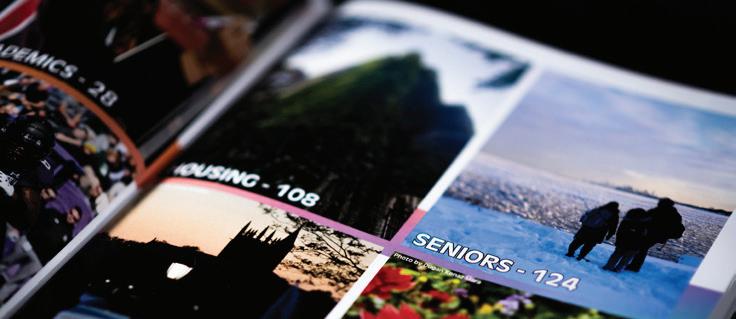

From page 1
Evanston, said while the proposed cuts aren’t entirely surprising, their sweeping nature is cause for concern. “I think we were all taken aback by how fast things have moved and by the lack of a fine-tooth comb,” Vick said. “They’re going in with a sledgehammer.”
The U.S. Department of Health and Human Services allocated about $12 billion to Head Start in fiscal year 2025, but Trump’s proposed 2026 budget would eliminate federal funding for the program altogether, according to reporting by The Washington Post. Vick said he learned of plans to defund Head Start through Project 2025 — a policy agenda crafted by conservative think tanks during Trump’s 2024 presidential campaign that explicitly calls for dismantling Head Start. Still, Vick emphasized that programs like those at IWSE have historically enjoyed bipartisan support in Washington.
IWSE operates with a $4 million annual budget and employs about 50 full-time staff, Vick said. The organization’s programming includes a Teen Baby Nursery
From page 1
cost-cutting measures and opening streams of funding.
From page 1
pressure.
English Prof. Barbara Newman acknowledged the challenges administrators have faced navigating the new federal administration, but emphasized the risks of complying with the Trump administration.
“Appeasement does not work,” Newman said. “I don’t think that trying to change our principles in order to bow to what the regime wants is going to help either us or the nation at large. So I want to encourage you to stand firm.”
From page 1
Biss and the City Council last week. The slideshow contained examples of Vielma’s social media posts, mostly from X or Reddit.
in the city’s 5th Ward that specifically supports the children of teen parents.
Currently, IWSE also partners with Evanston/ Skokie School District 65 as a subrecipient of the district’s federal Early Head Start grant. That partnership, however, is slated to end in June 2027 as the district looks to cut costs and reduce its reliance on external childcare providers.
Although District 65 funds make up about 25% of IWSE’s budget, Vick said he’s concerned other key funding streams, including the Illinois Child Care Assistance Program, could be jeopardized by potential spending cuts.
At the Childcare Network of Evanston, Head Start and Early Head Start grants account for about half of the organization’s budget, Executive Director Carol Teske said. Those funds allow CNE to provide a wide range of services — including early childhood education, mental health support and nutritional guidance — to low-income Evanston families.
“It’s not just serving the child who’s enrolled — it’s about serving the entire family in any way we can,” said Deepa Mehta, the director of programs at CNE.
Last week, NU announced that it would continue to fund research affected by the stop-work orders until the future of NU’s federal funding becomes more clear.
In response to the concerns, Hagerty assured faculty members of the University administration’s efforts to address the situation and emphasized the complexity of the circumstances.
The remainder of the meeting was spent discussing the 10 resolutions, which were met with some resistance as several faculty members expressed misgivings.
McCormick Prof. Seth Lichter criticized several of the resolutions, arguing that they weakened academic freedom and that AAUP was using the resolutions to advance other items on its agenda.
“We would all like our personal political views broadcast with the loudest megaphone and some of
Recent administrative changes have raised concerns that the Trump administration is already working to undercut Head Start programs, Teske said.
In addition to looming budget cuts, the federal government has frozen several grant portals and abruptly closed five regional Head Start offices, including the Chicago post that oversaw programs in Illinois and five neighboring states.
Mehta said her organization’s designated point person at the Chicago office offered vital support.
“She was the middle person between us and the Washington, D.C. Office of Head Start,” Mehta said. “Any compliance questions, any grant questions — all of those communications would have gone through her.”
CNE officials said they did not receive any advance notice of the closure and instead learned through news reports.
Moving forward, Vick said his organization’s priority will be to “empower parents” to advocate for themselves. That means encouraging families to contact their legislators, organize within their communities and speak out in defense of the Head Start program, he said.
“The University continues to engage with the federal government,” the University spokesperson wrote. “We are hopeful we will arrive at an equitable resolution that protects academic freedom, restores funding for
these resolutions are, I feel, disingenuously designed to do just that,” Lichter said.
Several faculty members questioned the need for such a broad range of resolutions, calling for a narrower set to address the upheaval brought on by the Trump administration.
Feinberg and psychology Prof. Dan Mroczek called the AAUP’s proposed resolutions “cluttered” and called for a more “simple and clean” set of resolutions. He also argued the resolutions erroneously pitted faculty against the University administration.
“Administrators and faculty are on the same side in this,” Mroczek said. “They are not our enemies. The
Both Vick and Mehta emphasized the importance of maintaining open and honest communication with parents who might be affected by spending cuts.
“The goal, in my opinion, of this administration is to create fear,” Vick said. “So we’re trying to have the approach of, ‘Let’s be honest with our families, and let’s give them facts.’”
That messaging, however, has been difficult to deliver amid growing uncertainty. Without clarity from federal agencies and with key administrative contacts suddenly inaccessible, local providers said they’re often left without answers themselves.
Teske said recent conversations with families have involved “lots of scenario planning” and have been “emotional,” primarily because most low-income parents know what they stand to lose if Head Start is dismantled.
“Some of our families — we’re like their family. We’re their only kind of support right now,” Teske said. “Basically, we’re taking away their safety net, and anybody in that position is going to be very uncomfortable.”
j.baker@dailynorthwestern.com
our research and ensures our campuses are free from discrimination and harassment.”
j.wu@dailynorthwestern.com
enemy is in the central government at this point.”
After a chance for commentary and discussion, the assembly passed the AAUP’s resolutions. The final vote count was announced in a Tuesday evening email to faculty members.
“I … do not agree with all or every single resolution as part of this proposal,” Communication Prof. Kyle Henry said at the meeting. “But I do think that we have to now put aside any of our singular reservations when we are seeing a concerted effort to attack the institution of higher education.”
s.draeger-mazer@dailynorthwestern.com
One of the X posts included in the presentation read, “If you’d like to drill a hole in your brain, please enjoy the public comment from the City of Evanston’s land use commission meeting. It’s live right now.”
EDITOR IN CHIEF
Lily Ogburn
MANAGING EDITORS
In her email to the council, Washburn asked councilmembers to consider this example and other comments “through the lens of the Evanston Code of Ethics,” claiming some of Vielma’s posts contained “inflammatory language and harassment.” Previously, Vielma told The Daily her social media comments evidenced her
engagement with the commission and residents. City Council was set to vote on confirming Biss’ selection at their April 28 meeting. Now, it is unclear when, or by whom, the seat will be filled.
In a statement to The Daily, Biss thanked Vielma for her commitment to affordable housing. “I support her decision to withdraw from this process and hope we can all use this situation as a reminder of the value of showing grace — to those we disagree with as well as to those who volunteer their time and talent for the betterment of our community,” Biss wrote. “I will work to fill the vacancy on the Land Use Commission promptly so it can continue its important work with a full complement of members.”
Spring 2025 | An independent voice since 1923 | Evanston, Illinois
AUDIO EDITOR
Izzie Jacob
ASSISTANT AUDIO EDITORS
Dov Elul, Valentina Valcarce
David Samson, Leah Schroeder, Shreya Srinivasan, Jerry Wu
MULTIMEDIA MANAGING EDITORS
Misha Manjuran Oberoi, Danny O’Grady, Anavi Prakash
CAMPUS EDITOR
Isaiah Steinberg
ASSISTANT CAMPUS EDITORS
Laura Horne, Sasha Draeger-Mazer, Lexi Newsom
CITY EDITOR
Hannah Webster
ASSISTANT CITY EDITORS
Jack Baker, Sophie Baker, Ben Shapiro
SPORTS EDITOR
Charlie Spungin
ASSISTANT SPORTS EDITORS
Andrew Little, Jonah McClure
OPINION EDITOR
Eli Kronenberg
ASSISTANT OPINION EDITOR
Gabe Hawkins
ARTS & ENTERTAINMENT EDITOR
Emily Lichty
ASSISTANT ARTS & ENTERTAINMENT EDITORS
Desiree Luo, Maya Wong
FEATURES EDITOR
Betsy Lecy
ASSISTANT FEATURES EDITOR
Nineth Kanieski Koso
IN FOCUS EDITORS
Aidan Johnstone, Madeline King
ILLUSTRATIONS EDITOR
Cayla Labgold-Carroll
ASSISTANT ILLUSTRATIONS EDITORS
Clare Kirwan, Siri Reddy
PHOTO EDITOR
Christina Lin
ASSISTANT PHOTO EDITORS
Marissa Fernandez, Dalton Hanna
VIDEO EDITOR
Sydney Gaw
ASSISTANT VIDEO EDITORS
Ridhima Kodali, Avantika Singh
DATA VISUALIZATION EDITOR
Sarah Serota
ASSISTANT DATA VISUALIZATION EDITOR
Brian Han
POLLING EDITOR
Scott Hwang
ASSISTANT POLLING EDITORS
Grace Wu, Navya Singh
CROSSWORD & GAMES EDITOR
Sejal Mehta
ASSISTANT CROSSWORD & GAMES EDITOR
Kate Pollot
DESIGN EDITORS
Henry Frieman, Rachel Schlueter, Matt Wasilewski
ASSISTANT DESIGN EDITORS
Clare Kirwan, Clara Martinez
WEB DEVELOPER
Yong-Yu Huang
h.webster@dailynorthwestern.com
AUDIENCE ENGAGEMENT EDITORS
Carlotta Angiolillo, Ashley Dong
NEWSLETTER EDITORS
Marisa Guerra Echeverria, Femi Horrall
ASSISTANT NEWSLETTER EDITOR
Lauren Kee
SOCIAL MEDIA EDITORS
Alexander Hernandez Gonzalez, Nineth Kanieski Koso
COPY CHIEFS
Caroline Killilea, Melody Xu
COPY EDITORS
Courtney Chen, Kamran Nia, Naomi Taxay
DIVERSITY & INCLUSION CHAIRS
Edward Simon Cruz, Janelle Mella
DEVELOPMENT AND RECRUITMENT EDITORS
Paloma Leone-Getten, Shun Graves, Alice Oh
STAFF EDITOR
Kelley Lu
GENERAL MANAGER
Stacia Campbell
SHOP MANAGER
Chris Widman
BUSINESS OFFICE STAFF
Jenny Aguilar, Branden Chen, Gabe Hawkins, Mia Schmitt, Kevin Tang
ADVERTISING PRODUCTION STAFF
Maia Alvarez, Christina Feng, Sammi Li
By ELI KRONENBERG DAILY SENIOR STAFFER @elikronenberg
Early in his tenure as Northwestern’s men’s tennis coach, Paul Torricelli traveled to Burlingame, California, to watch potential recruits at a prestigious junior tournament.
Hired ahead of the 1984 season to bring glory to a program that had gone over 20 years without a conference crown despite battling in the upper echelons of the Big Ten, Torricelli found his attention drawn toward a match between two spirited young personalities.
On one side of the net stood Steve Herdoiza of Bloomfield Hills, Michigan.
On the other, Gary Cohen of Tucson, Arizona.
“I lost pretty badly,” Cohen, an NU commit at the time, said. “The joke there is that after the match was over, we had a short conversation, and then (Torricelli) immediately hightailed it over to Steve Herdoiza.”
No one knew it at the time, but that encounter planted a seed that would eventually
tasted conference immortality.
Assembling the squad
Cohen arrived on campus in 1986 as part of a five-player freshman class acquired to inject life into the program. Yet, of the newcomers, only Cohen and one other player — Hawaiian-born Jim Cushing — survived to play on the Big Ten-winning team their senior year.
From the very beginning of their first year on campus, Cohen and Cushing established an unlikely friendship despite their wildly disparate personalities.
“Some people would call it good cop, bad cop,” Cohen said. “I was then and still am now, very direct, very straightforward. Some might say ‘in your face’ would have been a good way to describe me. … (Cushing) came at it in a very Hawaiian way. He’s very laid back and chill.”
In a transitional season for Cushing and Cohen, the ’Cats slumped to a ninthplaced finish in the Big Ten, one place from the basement in the conference’s days of nomenclatural accuracy. Yet, reinforcements would soon
beyond the rigid lines of the court to the nebulous world of recruiting.
According to Martin, he and Herdoiza had a “pretty heated rivalry” throughout their high school years in Michigan. But once Martin set foot in Evanston for a campus visit, everything changed.
“Steve just about tackled me and said, ‘You’ve got to come here, this is a great place,’” Martin said. “It was like his sense of competition with me had been extinguished by the culture of Northwestern. That meant the world to me.”
Coming into NU as the No. 3-ranked junior in the nation, Martin struggled to cope with the high demands of studentathlete life as he dealt with academic hardships and recurring sickness. He said he came “really, really close” to dropping out of NU.
“If I didn’t have wise adults in my life at the time, I would have,” Martin said.
Instead, Torricelli staged two crucial interventions: he introduced Martin to a University writing instructor and told him to go home to East Lansing, Michigan,

sprout into one of the most storied seasons in Northwestern sports history.
In 1990, the Wildcats lifted the Big Ten title, led by future two-time Grand Slam finalist Todd Martin, Herdoiza — the
be on the way — Herdoiza joined the ’Cats the following season.
“Todd was the best player I ever had, but Steve was the most important one,” Torricelli said. “When he got here,

accomplishment in persevering at the level that I did.”
Alongside Martin, Danish transfer Chris Gregersen joined the ’Cats’ roster prior to the 1989 season after sitting out the year before due to NCAA rules. Playing at Whitman College in his freshman year, Gregersen went on a run to the Division III singles final before making the leap to Big Ten tennis.
By that time, Cohen and Cushing were the team’s co-captains with two years of experience under their belt, helping to guide their younger, more prodigious teammates. Herdoiza established himself as the No. 1 singles player, while Martin slotted below him at No. 2.
The ’Cats finished third in the Big Ten that season, losing a heartbreaking Big Ten Tournament semifinal to Wisconsin, 5-4.
“When we lost, we all made a point to watch them celebrate,” Cohen said of the defeat to the Badgers. “We wanted to make sure none of us forgot that, because we all thought the next year we could do it.”
To the promised land
At the outset of the 1990 season, Torricelli made a promise. Despite boasting a mustache since graduating from high school, Torricelli told his players that he would shave if the team captured the Big Ten title.
for a week to reset mentally. The advice worked, and Martin steadily grew more comfortable.
“I just toiled through the rest of that year academically and got healthier, enjoyed





“Our big motivating factor was to trash the ‘stache,’” Herdoiza said. “That was really what I think propelled us that year to get over the top.”
Having made major improvements to his game over the summer, Mar-




victory at the Rolex National Indoor Championships.
After an inconsistent start to the season in which the ’Cats lost four of five matches on a westward spring break trip, Torricelli settled on a lineup that would propel NU to an undefeated conference slate.
Singles: No. 1 Todd Martin No. 2 Steve Herdoiza No. 3 Chris Gregersen No. 4 Jim Cushing No. 5 Marc Eisen No. 6 Gary Cohen
Doubles: No. 1 Martin/Gregersen No. 2 Cushing/Eisen No. 3 Herdoiza/Cohen
The final piece of the puzzle was freshman Marc Eisen, hailing from Milwaukee, Wisconsin, who was recruited to add further quality to the bottom portion of the lineup.
The top two singles positions proved all but guaranteed throughout conference play, as Martin finished 12-0 while Herdoiza went 11-1.
After finishing the conference season 9-0, the ’Cats entered the Big Ten Tournament as the No. 1 seed. They dispatched Illinois 5-0, setting up a semifinal matchup against Wisconsin, the team they narrowly lost to at the same stage the year before.
Leading 3-2 with all but one singles match concluded, Cohen saved eight match points at the No. 6 spot and prevailed 1-6, 7-6(6), 7-6(5) to give NU a crucial 4-2 lead heading into the doubles.
From there, Martin and Gregersen sent the ’Cats into the final with a characteristically dominant performance. After that match, Gregersen


After a dramatic semifinal, NU picked apart No. 2-seeded Indiana in a straightforward final.
Cushing was first off the court, and was followed in due course by Martin, Herdoiza and Gregersen.
With Cohen and Eisen still on court, the ’Cats needed just one win to seal their first Big Ten title in 27 years. As Cohen’s opponent opened up a 4-1 lead in the third set, eyes turned to Eisen at No. 5 — even Cohen’s attention strayed from his own match.
“I knew that we were up 4-0 and I knew that Marc Eisen was serving it out,” Cohen said. “All I did was basically watch Marc. I was just waiting.”
Sure enough, Eisen closed the lid on a 6-3, 6-4 victory and was mobbed by his teammates.
“I was the hero for about 30 seconds,” Eisen said. “That was definitely a team effort. It was just the icing on the cake for me to win the last match.”
Following the victory, the team lifted Torricelli on their shoulder, chanting, “Trash the ‘stache.” And the coach kept his promise. Soon after the title was clinched, Torricelli shaved off his mustache.
“They did me a favor,” Torricelli said. “It was time for a new look.”
elikronenberg2027@ u.northwestern.edu
